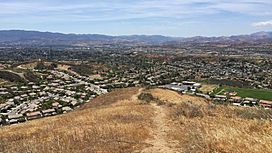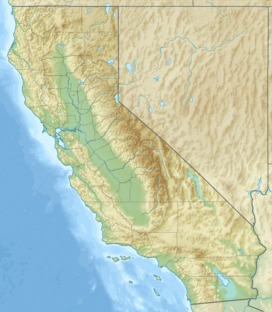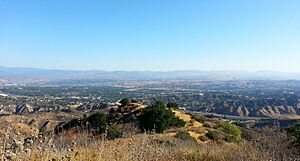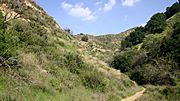Santa Clarita Valley facts for kids
Quick facts for kids Santa Clarita Valley |
|
|---|---|

View from the Sierra Pelona Mountains
|
|
| Floor elevation | 1,000–1,800 feet (300–550 m) |
| Naming | |
| Native name | Error {{native name}}: an IETF language tag as parameter {{{1}}} is required (help) |
| Geography | |
| Location | Los Angeles County, California, United States |
| Population center | Santa Clarita |
| Borders on | Santa Clara River Valley (west) Soledad Canyon (east) |
| Traversed by | Interstate 5, State Route 14 |
| River | Santa Clara River |
The Santa Clarita Valley (often called SCV) is a beautiful area in Southern California. It's where the upper part of the Santa Clara River flows. Long ago, this valley was part of a huge 48,612-acre (19,673 ha) land grant called Rancho San Francisco.
Today, the Santa Clarita Valley is in Los Angeles County. Its main city is Santa Clarita. This city includes popular neighborhoods like Canyon Country, Newhall, Saugus, and Valencia. Other nearby communities include Castaic, Stevenson Ranch, and Val Verde.
Contents
What's in a Name? The Valley's History
The Santa Clara River got its name from Spanish explorers. They named it after Clare of Assisi, a famous saint. Later, people started calling the valley "little Santa Clara." This was to show respect to the older mission and city of Santa Clara, California in Northern California. Over time, "little Santa Clara" became "Santa Clarita," which is the name we use today!
Exploring the Valley's Geography
The Santa Clarita Valley is surrounded by many interesting natural features. To the northwest, you'll find the Lake Piru area and Castaic Lake. The Sierra Pelona Mountains and Angeles National Forest are to the north and northeast.
The San Gabriel Mountains are to the east and southeast. To the south and southwest are the Santa Susana Mountains. To the west, you'll find Ventura County and the Santa Clara River Valley. The Topatopa Mountains are also nearby, to the west-northwest.
The Santa Clarita Valley is like a central hub, connecting to other valleys. You can reach the San Fernando Valley and Los Angeles Basin by going south through Newhall Pass. To the northeast, CA 14 takes you to the Antelope Valley through Soledad Pass.
If you head northwest on I-5, you can get to the San Joaquin Valley through Tejon Pass. You can also reach Leona Valley through San Francisquito and Bouquet canyons.
Downstream from the Santa Clarita Valley is the Santa Clara River Valley. This area is known as Heritage Valley and includes towns like Piru, Fillmore, and Santa Paula. Upstream, you'll find Soledad Canyon with communities such as Vincent, Acton, Ravenna, and Agua Dulce.
Understanding the Valley's Geology
The ground beneath the Santa Clarita Valley is made up of different types of rock and soil. Close to the surface, there are alluvial deposits from the recent past. Deeper down, you'll find coarse-grained conglomerates made of sandstone. These rocks formed from both ocean and land environments.
The far eastern part of the valley has older, coarse-grained sedimentary rocks. In the southern part of Bouquet Canyon, there are large areas of artificial fill.
Two main fault lines cross the valley. The San Gabriel Fault runs through the middle, from northwest to southeast. The smaller Holser Fault runs east to west between the Topatopa Mountains and Valencia. Neither of these faults has been active for a very long time.
The valley is also part of the Ventura Basin Province. This area is rich in petroleum and has a long history of producing oil and gas.
Santa Clarita Valley's Climate
The Santa Clarita Valley has a Mediterranean climate. This means it has hot, dry summers and mild, somewhat rainy winters. Snow is very rare here. Summer temperatures often go above 100 °F (38 °C), but winter nights rarely drop below 25 °F (−4 °C).
In late spring and early summer, mornings are often cloudy. This is due to a "marine layer" of clouds that forms off the coast and moves inland overnight. These clouds usually clear out of the valley by midday.
The valley is also known as a "wind-tunnel-like-corridor." This means it funnels strong winds, especially the Santa Ana winds, from the high desert towards the coast. These winds can spread wildfires quickly and are considered very dangerous in Southern California.
| Climate data for Santa Clarita, California (Dry Canyon Reservoir, 1961-1990 averages, 1921-1990 average monthly extremes) | |||||||||||||
|---|---|---|---|---|---|---|---|---|---|---|---|---|---|
| Month | Jan | Feb | Mar | Apr | May | Jun | Jul | Aug | Sep | Oct | Nov | Dec | Year |
| Record high °F (°C) | 91 (33) |
89 (32) |
91 (33) |
103 (39) |
110 (43) |
109 (43) |
117 (47) |
112 (44) |
115 (46) |
106 (41) |
99 (37) |
95 (35) |
117 (47) |
| Mean maximum °F (°C) | 77.2 (25.1) |
78.9 (26.1) |
82.5 (28.1) |
88.2 (31.2) |
95.4 (35.2) |
101.2 (38.4) |
104.9 (40.5) |
105.3 (40.7) |
103.3 (39.6) |
95.6 (35.3) |
86.0 (30.0) |
79.2 (26.2) |
107.7 (42.1) |
| Mean daily maximum °F (°C) | 63.7 (17.6) |
65.7 (18.7) |
68.3 (20.2) |
72.1 (22.3) |
78.7 (25.9) |
87.2 (30.7) |
94.2 (34.6) |
94.8 (34.9) |
89.4 (31.9) |
81.6 (27.6) |
69.0 (20.6) |
64.3 (17.9) |
77.6 (25.3) |
| Mean daily minimum °F (°C) | 35.4 (1.9) |
36.5 (2.5) |
37.8 (3.2) |
40.6 (4.8) |
45.4 (7.4) |
50.0 (10.0) |
54.5 (12.5) |
55.2 (12.9) |
51.4 (10.8) |
45.6 (7.6) |
38.5 (3.6) |
35.4 (1.9) |
44.0 (6.7) |
| Mean minimum °F (°C) | 26.4 (−3.1) |
28.9 (−1.7) |
30.7 (−0.7) |
34.0 (1.1) |
38.3 (3.5) |
43.1 (6.2) |
47.9 (8.8) |
48.7 (9.3) |
44.3 (6.8) |
37.3 (2.9) |
32.0 (0.0) |
27.0 (−2.8) |
24.8 (−4.0) |
| Record low °F (°C) | 16 (−9) |
20 (−7) |
19 (−7) |
28 (−2) |
28 (−2) |
33 (1) |
39 (4) |
40 (4) |
33 (1) |
22 (−6) |
24 (−4) |
15 (−9) |
15 (−9) |
| Average precipitation inches (mm) | 2.68 (68) |
3.14 (80) |
2.46 (62) |
1.04 (26) |
0.26 (6.6) |
0.03 (0.76) |
0.03 (0.76) |
0.18 (4.6) |
0.34 (8.6) |
0.42 (11) |
1.83 (46) |
1.98 (50) |
14.40 (366) |
Wildfires in the Valley

The hills around Santa Clarita are often dry and covered in brush and chaparral. This makes the area prone to wildfires. While fires are most common in summer and fall, they can happen any time during dry conditions. For example, there were fires in December 2017. The risk of wildfires is highest when the strong Santa Ana winds blow through the area from the Mojave Desert.
Some important wildfires in the Santa Clarita Valley's history include the Buckweed Fire, Sand Fire, Rye Fire, Tick Fire, and Maria Fire.
Wildlife and Nature in the SCV
The Santa Clarita Valley is a special place where two different natural areas meet. To the southwest, you'll find the California coastal sage and chaparral ecoregion. To the northeast, there's the California montane chaparral and woodlands ecoregion. These areas are recognized by the WWF.
You might spot some interesting animals living here. Common residents include bobcats, coyotes, red-tailed hawks, and desert cottontail rabbits.
Fun Things to Do in Santa Clarita Valley
The Santa Clarita Valley is a great place for entertainment and outdoor activities! It's about 20 miles (32 km) from the Burbank Bob Hope Airport and 35 miles (56 km) from Los Angeles International Airport.
One of the biggest attractions is Six Flags Magic Mountain, a huge 262-acre (106 ha) theme park. It also has a waterpark called Six Flags Hurricane Harbor.
There are many other family-friendly places, too:
- The Santa Clarita Aquatics Center for swimming.
- Copper Horse Riding Ranch for horseback riding.
- The Cube (formerly Ice Station Valencia) for ice skating.
- Lots of restaurants and shopping centers.
- Golf courses, cinemas, and theaters.
- Relaxing day spas.
For outdoor fun, you can visit Castaic Lake, Placerita Canyon, and Santa Clarita Woodlands Park. The valley also has many parks and over 70 miles of trails for hiking and biking. You can even visit animal sanctuaries like the Gentle Barn and the Gibbon Conservation Center.
The Santa Clarita Valley has a rich Western heritage. You can explore historical sites like the old oil drilling town of Mentryville, the Walk of Western Stars, and the William S. Hart Ranch and Museum. Since 1994, the valley has hosted an annual Santa Clarita Cowboy Festival. This popular event attracts more than 10,000 visitors every year!
Learning and Education in the Valley
For younger students in Santa Clarita, there are several elementary school districts. These include the Castaic, Newhall, Saugus, and Sulphur Springs districts. Most junior high and high schools are part of the William S. Hart Union High School District. However, Castaic Middle School is part of the Castaic Union School District.
The mountain communities of Acton and Agua Dulce have their own school district, the Acton-Agua Dulce Unified School District. It serves students from kindergarten all the way through 12th grade.
For students who want to continue their education, the valley has three colleges and universities:
- College of the Canyons
- California Institute of the Arts
- The Master's University






